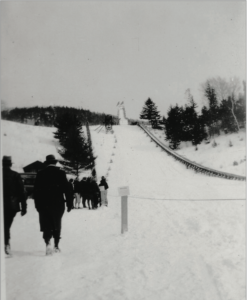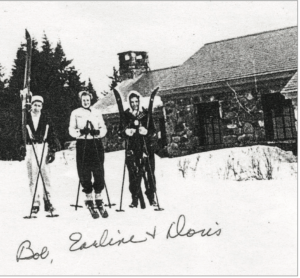By Karen D. Lorentz
Editor’s Note: This is the first of a three-part series on the early “lost” ski areas that propelled several generations of skiers in the greater Rutland Region.
Vermont skiing dates back to 1892 when the Woodstock Inn opened and winter guests took cross-country ski treks to the nearby country club. By 1910 the Inn had built a winter sports center, including ski and toboggan runs — with uphill transportation provided by horse-drawn sleigh rides — and a ski jump.

Mendon Ski Center with toboggan chute to right ski jump center and slopes left.
Due to the influence of Finnish, Norwegian, and Swedish populations, people used cross-country skis for travel and outings and held jumping contests in communities throughout Vermont in the early 1900s.
By the 1920s they were tramping around hills on alpine skis, too. It was a time when snow sports were celebrated, and there were those who were extolling winter recreation as a “new industry” for New England’s economy.
That exuberance had roots in a Brattleboro native son’s love affair with winter. Ski jumper Fred Harris, who founded the Dartmouth College Outing Club (1909) and the collegiate Winter Carnival, opined that being cooped up indoors was unhealthy, both mentally and physically.
Following his example, Middlebury College students formed an outing club in 1916 and organized ski and snowshoe teams, giving a big boost to alpine skiing’s popularity.
Collegiate enthusiasm led to the formation of winter sports clubs throughout Vermont. Annual winter carnivals followed, along with winter competitions for children. Fresh air was viewed as a healthy way to help people escape the ravages of illness and influenza in the years before antibiotics.
First of the lost local areas
The Rutland Exchange, or the Ski Club, joined in the winter craze by building the Mendon Winter Sports Center at the Barker Farm on Town Line Road. This area sported a toboggan chute, ski jump, canteen, and open slopes for skiers. A story in the Jan. 3, 1927 Rutland Herald noted the tremendous popularity of the site, reporting that on January 2, there were over 1,000 visitors, with hundreds trying out their new Christmas skis and another 500 using the toboggan chute. The Great Depression is thought to have contributed to the area’s demise.
When the Civilian Conservation Corps built the CCC Road and a state park between the towns of Plymouth and Shrewsbury, the Rutland Ski Club proposed ski trails on Shrewsbury Peak. State Forester Perry Merrill obliged, and the CCC installed a rope tow in January 1936. The Shrewsbury Peak Ski Area AKA The Rutland Ski Club Area had a base elevation of 2,200 feet and boasted long runs and trails that separated skiers by ability level.
There was a 2,650-foot Novice Run, the 2,535-foot Rattlesnake Run (intermediate), the 4,985-foot Chain Lightning Run (expert), and the 12,590-foot-long Horse Trail that required a long hike up to the peak for a thrilling 1,585-foot vertical descent.
A two-acre Open Slope was located at the base with a 1,200-foot rope tow. At the top of the tow, there was a short hike to the start of the trails, which looped around the backside the promontory.
The area boasted a canteen and hosted several college meets as well as skiers who arrived in Rutland by snow train. The area, which was difficult to get to over the snowy mountain road, ceased operations when World War II broke out.
Brad and Janet Mead, who had skied at Shrewsbury, established a rope tow at Framer’s Farm in Mendon in 1936-37, but it only survived one season as the next season they opened Pico Peak on Thanksgiving Day (1937).

Doris King with friends at the Stone House when Shrewsbury Ski Area operated.
Richard Candlish operated Dick’s Ski Tow near Bill’s Country Store in Sherburne (name later changed to Killington due to mail confusion with Shelburne, and the store now houses the local Chamber of Commerce) during World War II. He charged 50 cents for Thursday or Friday nights and 75-five cents for Saturdays or Sundays. After the war, he sold the tow to Claus Bartenstein, who moved it to North Sherburne where he ran the Retreat Ski Area until 1950.
The Maplewood Winter Sports Area in Rutland opened in 1939 and had a toboggan chute for a while and a 400-foot tow that served open practice slopes (and later two ski trails). It was located on an apple orchard just south of Fair Haven.
There was a portable rope tow on the Rutland Country Club golf course (1950s) and many children and adults learned to ski there. Rope tows also operated for a period of time in Brandon, Proctor, Goshen (Blueberry Hill), Middletown Springs (Burnham Hollow), and Chittenden (Mountain Top Inn Area) before disappearing.
There were more extensive ski operations at Green Mountain College in Poultney and the High Pond Ski Area in Hubbardton. They were operated by the late Bill Jenkins who also started the Birdseye Ski Area in Castleton. Like other “lost” ski areas in Vermont, these early areas succumbed to the war or later to a lack of snowmaking and the cost of liability insurance as well as the competition from larger areas like Pico, Killington, and Okemo. But not before they spawned an enthusiasm for outdoor winter recreation in winter that continues to this day.
Next week we’ll take a look at one of the local entrepreneurs who taught hundreds of new women skiers to ski and operated three of the most influential early “lost” ski areas.




